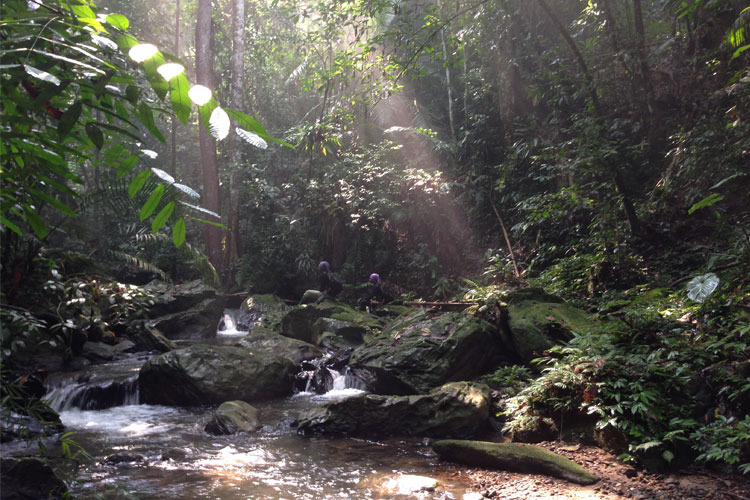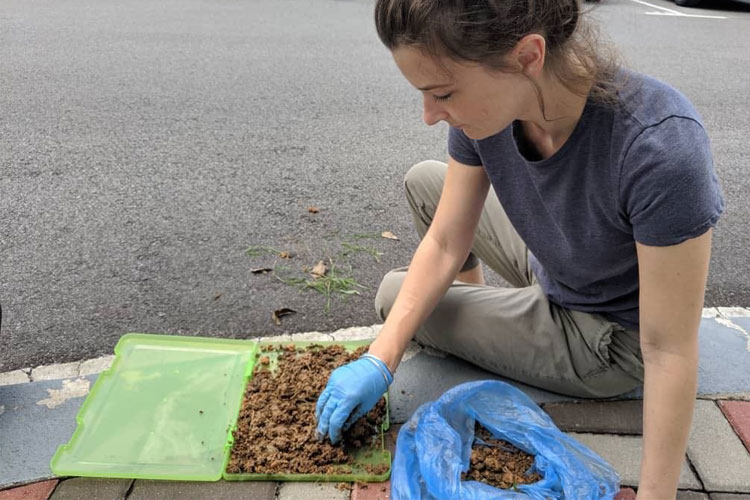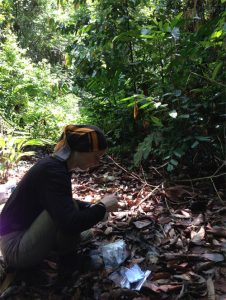Kate Allberry is a PhD student in Biodiversity Management at the Durrell Institute of Conservation and Ecology (DICE), researching how environmental change influences the movement of Malaysia’s apex predators in wildlife corridors. Kate writes about conducting research from her field site in the Belum Temengor Forest Complex in Malaysia:
“I am sat in a hammock in the middle of the jungle. It is seven o’clock at night. On my right is Enry, one of my research assistants from the local Orang Asli Jahai community, inspecting the topographic map on a GPS (Global Positioning System) for tomorrow’s survey. Razali is on my left, dozing in his hammock. Our camp, surrounded by forest and set next to a small, shallow river, consists of three hammocks under a tarpaulin, a cooking area made from bamboo and a fire to keep elephants and other curious wildlife away at night.
“I am currently working in the Belum Temengor Forest Complex in Peninsular Malaysia, one of the world’s oldest rainforests (older than the Amazon and Congo). My PhD research aims to assess the effects of deforestation and climate change on the genetic connectivity of big cats. This means I need to collect samples which contain DNA from different felids (wild cats), in order to determine how genetically similar they are. The genetic diversity of a species is a marker of its health: the greater the diversity, the better equipped the species is to adapt to habitat loss and climate change. Loss of genetic diversity can result in lower reproduction rates, greater susceptibility to disease and reduced ability to adapt to external change in the long-term.
“Enry and Razali are expert indigenous citizen scientists and my eyes and ears in the forest: navigating tricky jungle terrain, operating GPS, carrying heavy packs full of camping gear and rations, and finding and collecting DNA samples. Razali decides he wants a snack and we all sit eating leftover rice and veg folded in bread, followed by a conversation of how great just about anything is folded in bread. Evenings often involve huddling around a map and GPS, planning the next day’s trek. Despite my poor Malay, we manage to have broken yet interesting conversations about politics, relationships, work…and food in folded bread. I’m very glad they’re with me.
“A typical day involves waking up around seven in the morning, eating rice for breakfast and putting on damp field clothes from the day(s) before. I compile my day pack (GPS and map (critical), scat collection kits, spare batteries (more critical), satellite phone, first aid kit, parang (like a machete – also critical, but never quite sure how to use it properly) and snacks (most critical)) and we set off in search of hidden samples.
“Each stay in the forest lasts for about a week. We trek for most of the day, walking anything from 6 km to 14 km, depending on the terrain and forest density.

“I have just finished writing data forms from today’s trek. This mostly involves capturing any significant findings or observations from the day alongside a detailed description of each sample found. In my case, this means writing about scat (poop) and spoor (paw prints) each day. Every little detail about the sample is captured on paper, from its suspected age, form (size, shape, colour) and where it was found, to the potential owner and whether it’s a lone poop or not. Keeping a written log of your fieldwork is also vitally important: seemingly superfluous details at the start might be golden nuggets of information further down the line, so it’s best to capture everything.
“Poop might seem like an odd thing to write about, but conservation biologists are actually detectives. Doctoral research is a bit like piecing together a large, complex puzzle and overcoming numerous expected and (mostly) unexpected challenges with every fragment. My research is field- and lab-intensive, which means running back and forth between the forest in the north, bordering Thailand, and my lab further south in Kuala Lumpur, trying to find precious samples, and then trying to salvage the DNA from those samples as quickly as possible. My day off is often the long drive back from my fieldhouse to Kuala Lumpur, trying to get my brain to switch mode for high-concentration DNA analysis.

“Lab work is pretty gruelling: wild tiger poo does not behave the same way as captive lab poo because of the extreme degradation that occurs in tropical environments. So extracting DNA sometimes takes three, four or more repeats to get a positive result for species/individual identification. One positive sequence from a single Asian golden cat has just taken four months to validate: a little frustrating but totally worth the wait! Fortunately, I am surrounded by some brilliant conservation geneticists at the National Wildlife Forensics Laboratory of the Department of Wildlife and National Parks Peninsular Malaysia (PERHILITAN), who are helping me along the way and uncovering some very cool things about some very elusive cats.

“PhD research is tiring but thrilling. It pushes you beyond your comfort zone – both professionally and personally – and encourages you to reflect on, adapt and maybe rethink your approach to conservation. Fortunately, DICE has a close-knit PhD community of open minds and good friends, with the guidance of some highly experienced and supportive staff. Sometimes debate can be challenging, but this is important for shaping your own views, building confidence and preparing you for a life in conservation. But having the chance to spend three or four years conducting your own conservation research is a once-in-a-lifetime opportunity.
“For now, I will sit in my hammock and listen to nature bedding down for the night, ready to start all over again tomorrow.”

